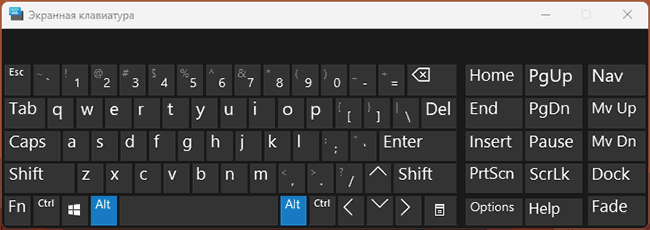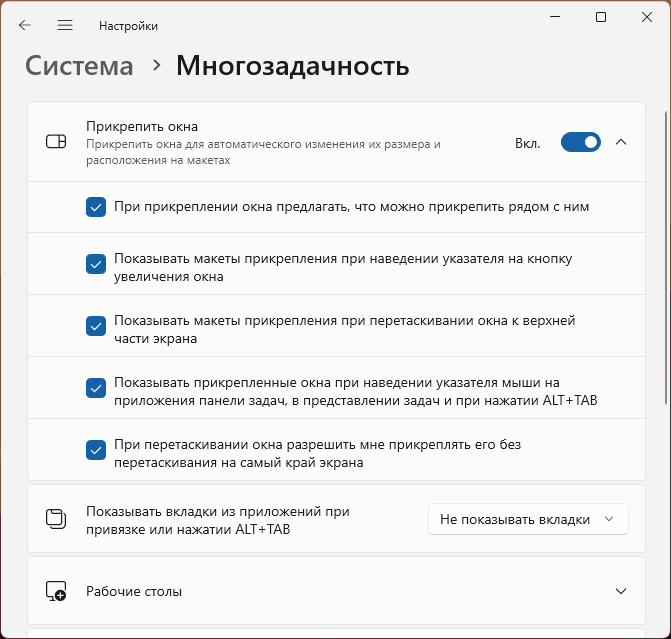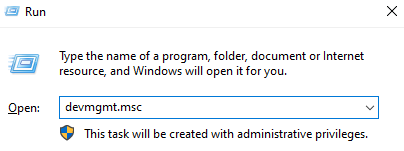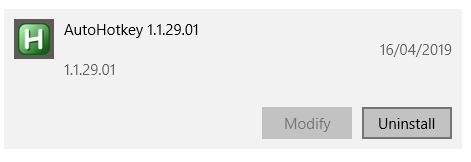Некоторые пользователи, активно использующие горячие клавиши при работе в Windows 11 или Windows 10 могут столкнуться с ситуацией, когда сочетание Alt+Tab для переключения между открытыми окнами программ перестаёт работать.
В этой инструкции подробно о том, чем может быть вызвано такое поведение и как исправить ситуацию.
Проверка работы клавиш
Если вы столкнулись с тем, что сочетание клавиш Alt+Tab перестало работать, рекомендую начать с проверки: не в самих ли клавишах дело. Сделать это можно с помощью следующих подходов:
- Откройте экранную клавиатуру (Win+R — osk.exe) и проверьте, сработает ли сочетание на ней. Если да — причина, похоже, именно в клавишах на клавиатуре. В этом случае следует проверить работу клавиш Alt и Tab в других задачах и сочетаниях.
- При наличии второй клавиши Alt на клавиатуре, попробуйте использовать сочетание с ней, вместо привычной вам.
- Если у вас есть вторая клавиатура, проверьте, начнёт ли работать сочетание клавиш, если подключить её.
Дополнительно можно проверить, сработает ли схожее по функциональности сочетание клавиш Win+Tab.
Если ни один из вариантов не приводит к срабатыванию сочетания, проблема, вероятно программная, в этом случае переходим к следующим вариантам решения.
Исправление работы клавиш Alt+Tab
Далее — варианты решения проблемы с работой сочетания клавиш Alt+Tab в Windows от простым к более сложным:
- Зайдите в Параметры (клавиши Win+I) — Система — Многозадачность и изучите доступные параметры (отличаются в различных версиях системы), в частности — пункт «Показывать прикрепленные окна при наведении указателя мыши на приложения панели задач, в представлении задач и при нажатии Alt+Tab».
- Проверьте, начинают ли работать клавиши сразу после перезагрузки компьютера (или после завершения работы с удержанием клавиши Shift). Если это решает проблему, попробуйте отключить быстрый запуск Windows.
- Если на компьютере используются какие-либо программы для макросов или переназначения клавиш клавиатуры, проверьте, изменяется ли ситуация, если отключить их.
- Проверьте, не включено ли залипание клавиш и фильтрация ввода Windows. Если включено — попробуйте отключить.
- В случае если вы столкнулись с проблемой недавно, можно использовать точки восстановления системы на дату, когда всё работало исправно.
- Проверьте работу сочетания клавиш в режиме чистой загрузки — если при этом оно начинает работать, есть вероятность, что какое-то стороннее приложение или служба мешает их работе при обычной загрузке.
Надеюсь, один из предложенных вариантов сможет вам помочь и решить проблему.
Дополнительная информация
Некоторые дополнительные нюансы, касающиеся работы клавиш Alt+Tab:
- В Windows присутствует дополнительный метод переключения между окнами открытых программ: зажать левую клавишу Alt, нажать (но не удерживать) правый Alt, нажать Tab.
- Некоторые полноэкранные приложения (например, игры), могут блокировать использование рассматриваемого сочетания клавиш, пока вы не выйдите из них.
- В ситуации, когда рассматриваемое сочетание клавиш большую часть времени работает, но иногда перестаёт, может помочь перезапуск Проводника в диспетчере задач.
- Если речь идёт о компьютере в организации, некоторые сочетания клавиш могли быть отключены с помощью функций фильтрации клавиатуры (Keyboard Filter), подробнее на сайте Майкрософт.
You may always use the Alt + Tab shortcut key to switch among running applications. But sometimes, you may find this way not working. In this article, MiniTool shows you some solutions to fix this issue.
Alt Tab Not Working
Once we use our computer, we always run many applications or documents in same time. To flip back and forth between two frequent-used applications or documents worked on Windows, you can use the Alt + Tab shortcut key.
However, when you press Alt + Tab, Windows is not showing anything or it shows opened applications or documents for one or two seconds and then disappears. This means “Alt Tab not working”.
You may wonder why this issue occurs. There are various reasons behind this issue, such as the keyboard, wrong system settings, the conflict between files, and so on.
Now, let’s see how to fix “Alt Tab not working”. Here I recommend you to try turning off your machine and uplging all cables at first. Then wait for a few minutes, plug all cables back, and turn on your machine and monitor. Finally, check whether “Alt Tab not working” has been solved. If not, please try the following ways.
Fix 1: Check Your Keyboard
The keyboard is one of the reasons for “Alt Tab not working”. Therefore, you can check your keyboard by the following steps:
Step 1: Connect another USB keyboard with your PC.
Step 2: Try Alt + Tab shortcut key on the newly-connected keyboard.
Step 3: If this shortcut key works, there might be something wrong with your original keyboard. In this situation, you need to buy a new one for your computer. If this shortcut key also fails, you can try reinstalling the keyboard driver.
Here is the tutorial on reinstalling the keyboard driver:
Step 1: Type Device Manager in Cortana’s search bar and select the best-matched result.
Step 2: In the Device Manager window, please locate Keyboard and expand this option. Right-click the displayed device and select Uninstall device.

Step 3: Restart your computer to apply the changes. Upon restart, Windows will automatically download and install the latest keyboard drivers.
If the above method failed, you can use a professional third-party program to update drivers. Driver Easy Pro can detect all outdated drivers and update them with just one click. Here is the guide:
Step 1: Install Driver Easy and launch it. Click the Scan Now button.
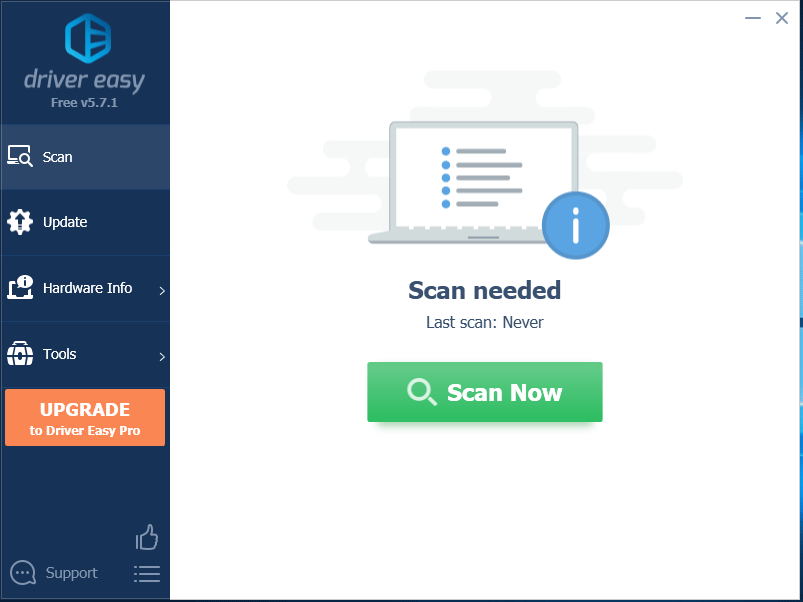
Step 2: After the scanning process is completed, click the Update All button to download and install the latest drivers for all devices with outdated drivers.
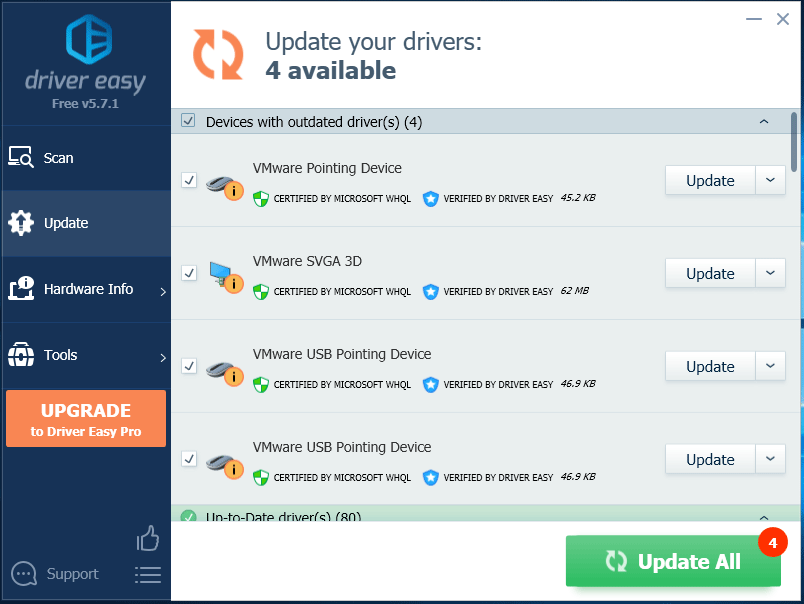
Fix 2: Change Alt Tab Value in Registry
This fix is to check the Alt Tab Registry values to get the shortcut key available. To check that, please do what the following tutorial shows.
Step 1: Press the Windows + R keys on the keyboard at the same time to get the Run box.
Step 2: Once the Run box pops up, please type regedit and click OK.
Step 3: After accessing the Registry Editor window, please navigate to the following path:
Computer > HKEY_CURRENT_USER > Software > Microsoft > Windows > CurrentVersion > Explorer
Step 4: Find AltTabSetings in the Explorer section and double-click it.
Note: If this file is unavailable, you need to create it. To do that, simply right-click the right pane and choose New > DWORD (32-bit) Value. Then name it as AltTabSettings.
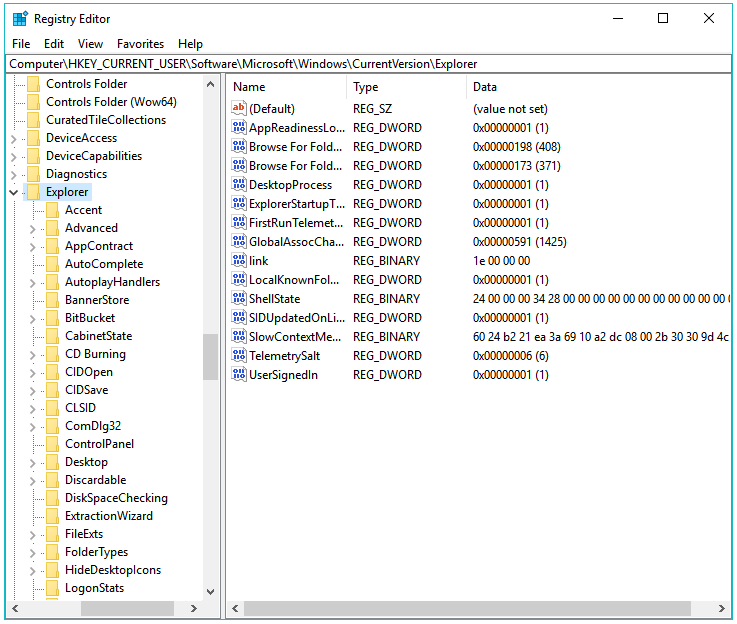
Step 5: After getting a small pop-up window, change the value data to 1 and click OK to saves the changes.
After finishing the above steps, the issue should be solved.
Fix 3: Restart Windows Explorer
Here comes the third fix to make the Alt + Tab shortcut key work on Windows 10. That is restarting your Windows Explorer:
Step 1: Right-click the Taskbar and select Task Manager.
Step 2: Locate the Windows Explorer process, right-click it and choose Restart.
After accomplishing the two steps, your Windows Explorer should restart and Alt + Tab shortcut key should be working. Please note you will have to repeat the two steps if the issue appears again since this fix is just a temporary solution.
Fix 4: Check Hotkeys
Sometimes “Alt Tab not working” can be ascribed to the disabled hotkeys. Why did hotkeys be disabled? The reason is that malware or infected files can disable the hotkeys on your system. (To protect your data and documents saved in your computer, you can enable the Controlled Folder Access feature built in Windows 10.)
Therefore, you should check whether your hotkeys were disenabled.
Step 1: Access the Run box again, type gpedit.msc and click OK to open Group Policy Editor.
Step 2: Once get the Group Policy Editor window, you are required to expand the following folders one by one:
Local Computer Policy > User Configuration > Administrative Templates > Windows Components > File Explorer
Step 3: Scroll down the left side until you find the Turn off Windows Key hotkeys option. Double-click this option and then select the Enable option.
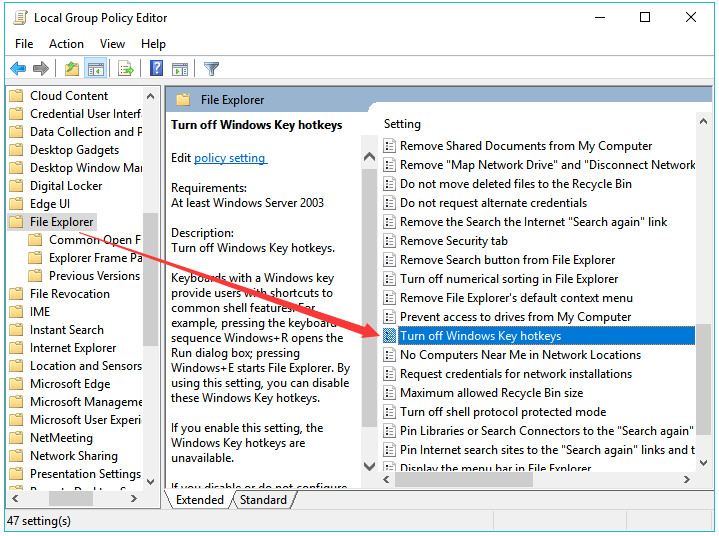
Step 4: Click Apply and OK in order to save changes.
Now check if this issue has been troubleshot. If not, you should repeat the above steps but this time you need to select Disabled option.
Fix 5: Enable the Peek Option
According to users’ feedback, they have solved “Alt Tab not working” by simply enabling Peek option in Advanced System Settings. Therefore, have a try.
Step 1: Get Run box, input sysdm.cpl and click OK to open System Properties.
Step 2: Move to the Advanced tab and click Settings under Performance.
Step 3: Make sure the Enable Peek option in the Performance Options window is checked. If not, please check it.
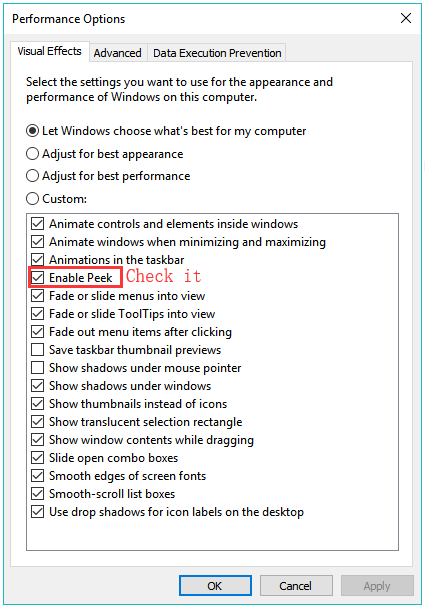
After finishing, please check if the issue has been resolved.
How do you switch between different tabs on your device? The answer would be Alt + Tab. This shortcut key is the most used one. It made switching between open tabs on your system easy in Windows 10. However, there are some occasions when this function stops working. If you are experiencing this problem on your device, you need to find out the methods to Fix Alt+Tab Not Working in Windows 10. When it comes to finding out the causes of this problem, there are several reasons. However, we will focus on the methods to solve this problem.

In this article, we are going to cover the following issues:
- ALT+TAB doesn’t work: Alt + Tab shortcut key is very important to switch between the open program window, but users are reporting that sometime it doesn’t work.
- Alt-Tab sometimes stops working: Another case where Alt + Tab doesn’t work sometimes means its a temporary issue that can be resolved by restarting Windows Explorer.
- Alt + Tab does not Toggle: When you press Alt + Tab, nothing happens, which means it does not toggle to other program windows.
- Alt-Tab disappears quickly: Another issue related to Alt-Tab keyboard shortcut. But this can also be resolved using our guide.
- Alt-Tab not switching windows: Users are reporting that Alt+Tab shortcut doesn’t switch windows on their PC.
Table of Contents
Fix Alt+Tab Not Working (Switch Between Programs Windows)
Make sure to create a restore point just in case something goes wrong.
Method 1: Change the Registry Values
1. Open Run command by pressing Windows + R.
2. Type regedit in the box and hit Enter.

3. Navigate to the following path:
HKEY_CURRENT_USER\Software\Microsoft\Windows\CurrentVersion\Explorer
4. Now look for the AltTabSettings DWORD. If you do not find the one, you need to create the new one. You need to right-click on the Explorer key and choose New > Dword (32-bit) Value. Now type the name AltTabSettings and hit Enter.

5. Now double click on the AltTabSettings and set its value to 1 then click OK.

After completing all these steps, you may be able to Fix Alt+Tab Not Working in Windows 10 issue. However, if you still experience the same problem, you can implement the other method.
Method 2: Restart Windows Explorer
Here comes another method to get your Alt+Tab function working. It would help if you restarted your Windows Explorer which may solve your problem.
1. Press Ctrl + Shift + Esc keys together to open Task Manager.
2. Here you need to locate Windows Explorer.
3. Right-click on Windows Explorer and select Restart.

After this Windows Explorer will restart and hopefully the problem will be solved. However, it would help if you kept in mind that this is a temporary solution; it means you have to repeat it repeatedly.
Method 3: Enable or Disable Hotkeys
Sometimes this error occurs just because the hotkeys are disabled. Sometimes malware or infected files can disable the hotkeys on your system. You can disable or enable the hotkeys using the below steps:
1. Press Windows + R and type gpedit.msc and hit Enter.

2. You will see Group Policy Editor on your screen. Now you need to navigate to the following policy:
User Configuration > Administrative Templates > Windows Components > File Explorer

3. Select File Explorer than on the right pane, double-click on Turn off Windows Key hotkeys.
4. Now, under the Turn off Windows Key hotkeys configuration window, select Enabled options.

5. Click Apply, followed by OK to save changes.
Now check if you’re able to Fix Alt+Tab Not Working in Windows 10 issue. If the problem is still there to haunt you, you can follow the same method, but this time you need to select the Disabled option.
Method 4: Reinstall the Keyboard Driver
1. Open Run box by pressing Windows + R simultaneously.
2. Type devmgmt.msc and hit enter to open Device Manager.
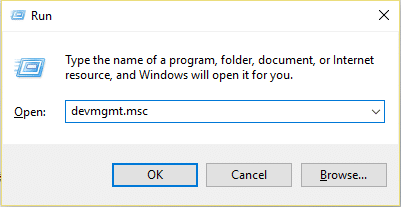
3. Here, you need to locate Keyboard and expand this option. Right-click on the keyboard and select Uninstall.

4. Restart your system to apply the changes.
Upon restart, Windows will automatically download and install the latest keyboard drivers. If it does not install the driver automatically, you can download the driver from the keyboard manufacturer’s official website.
Method 5: Check your keyboard
You can also check whether your keyboard is functioning properly or not. You can remove the keyboard and connect other keyboards with your PC.
Now try Alt + Tab, if it is working, it means your keyboard is damaged. This means you need to replace your keyboard with a new one. But if the problem persists, you need to opt for other methods.
Method 6: Enable the Peek option
Many users solve their Alt + Tab not working issue by simply enabling Peek option in Advanced System Settings.
1. Press Windows Key + R then type sysdm.cpl and hit Enter to open System Properties.
2. Switch to Advanced tab then click on the Settings button under Performance.

3. Here, you need to make sure that Enable Peek option is checked. If it is not, you need to check it.

After completing this step, you need to check whether the problem is solved and Alt+ Tab function started working.
Recommended:
- Right Click using the Keyboard in Windows
- Share Your Google Calendar With Someone Else
- What is Disk Management & How to use it?
- Fix Can’t Turn ON Windows Defender
Hopefully, above mentioned all methods would help you to Fix Alt+Tab Not Working in Windows 10. However, in case you want to connect and get more solutions, comment below. Please follow the steps systematically to avoid any problem on your PC.
Rick Akura
Windows is packed with useful keyboard shortcuts for faster navigation. In this article, you learn how to fix Alt-Tab Shortcut Not Working on Windows 10.
Windows is packed with useful keyboard shortcuts that make it faster to navigate your system. The most used one is pressing the Alt and Tab keys at the same time, allowing you to see an overview of your open windows and switch between them at lightning speed.
It’s easy to see why the shortcut not working could cause issues for many people. It’s essential to anyone that frequently toggles between their apps to achieve more efficient work. Learn how to fix the Alt-Tab key shortcut not working on Windows 10 by reading our article.
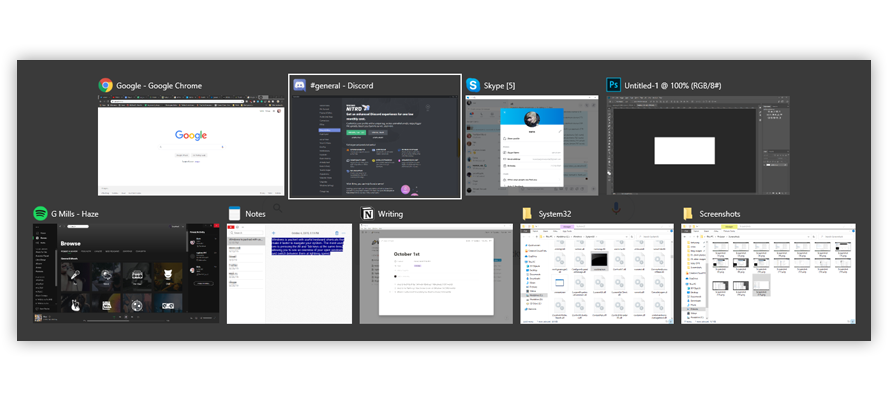
Jump to Section:
- Why is the Alt-Tab shortcut not working on Windows 10?
- Method 1: Make sure it’s not your keyboard
- Method 2: Use the other Alt key
- Method 3: Restart Windows Explorer
- Method 4: Change the AltTabSettings Registry values
- Method 5: Update your keyboard driver
- Method 6: Make sure Peek is enabled
- Method 7: Uninstall third-party keyboard apps
- Method 8: Disconnect peripherals
- Conclusion
Why is the Alt-Tab shortcut not working on Windows 10?
Issues with shortcuts are usually tied to system mishaps, meaning they’re unique to each computer. Here are some of the most common offenders when it comes to your shortcuts not functioning on Windows 10:
- Registry changes. The Windows Registry is responsible for handling many parts of your system under the hood. Some applications make new registry entries when installed, which may cause conflicts with already existing ones. This can lead to your system not recognizing Alt-Tab as the shortcut for switching apps.
- Shortcut override. It’s entirely possible that an application you installed did an override on the already existing Alt-Tab shortcut, meaning that it has a different function in your system now.
- Windows Explorer error. Windows Explorer is one of the many backbones of your system. If it encounters an error, it’s possible that it might mess with the functionality of your system, including its shortcuts.
- Peripherals. Your peripherals, such as a keyboard, computer mouse, or headset can cause the Alt-Tab shortcut to stop working.
- Drivers. Drivers make most of your peripherals work. If your drivers are missing, outdated, or not compatible with your system, they may interfere with the functionality of the Alt-Tab shortcut amongst many other issues.
Other issues might be present on your PC that cause the Alt-Tab keys to not function as intended. We bring you various fixes below to help you solve this annoying error no matter what the source of it is.
To ensure you can stay efficient on your device, we’ll help you fix any errors regarding the Alt-Tab shortcut not working on your Windows 10 system. Some of these methods are more general troubleshooting, but many of them focus on known issues related to this shortcut.
Let’s begin troubleshooting!
Method 1: Make sure it’s not your keyboard
First and foremost, you should check if your keyboard is working properly, and it isn’t damaged in any way. Keys are fragile, and they may break or not press down properly if something happens to them.
You can check if your Alt and Tab keys work by going on a website that automatically detects and shows which keys you press down. We recommend using Key-Test.
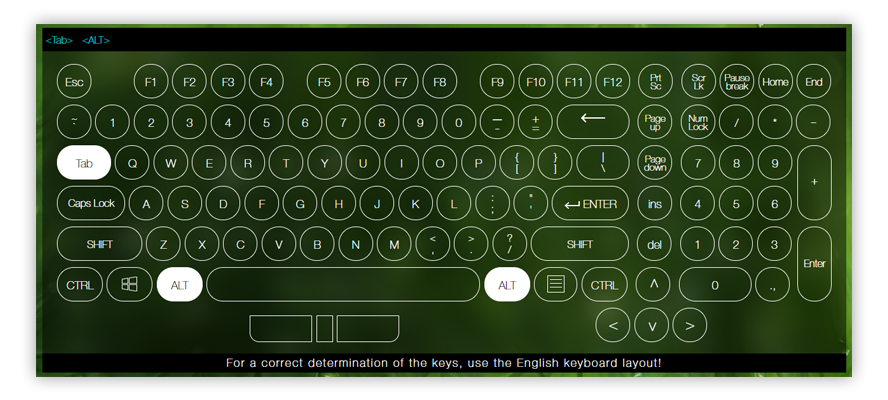
The tester is unable to determine between duplicate keys such as Alt. Make sure you test both and see the on-screen keyboard highlight the Alt key as you press them!
If your Alt and Tab keys are working properly, this is how the on-screen keyboard should look like. Are you seeing only one of the keys light up? This is an indicator that something is wrong with your keyboard. Consider cleaning it, or testing if Alt-Tab works with a different keyboard.
Method 2: Use the other Alt key
There are two Alt keys on your keyboard. If the Alt-Tab function doesn’t seem to work with one of them, try the other one! Many users report that after using the secondary Alt key to perform an Alt-Tab window switch, their primary Alt key also started working in the shortcut.
Another thing you can try is the Alt-Tab-Esc shortcut, which often seems to fix issues with Alt-Tab in general.
Method 3: Restart Windows Explorer
Windows Explorer essentially allows you to browse your files with a visual interface. It’s often regarded as the backbone of your system since most of us wouldn’t know how to navigate our PCs without it.
Restarting the Windows explorer often seems to fix issues with the Alt-Tab keys not functioning as intended. Here’s how to do it.
- Launch the Task Manager:
-
Right-click on an empty space in your taskbar and choose Task Manager,
- or use the Ctrl + Shift + Esc shortcut.
-
Click on More details.
-
Select Windows Explorer and right-click on it, then choose Restart from the context menu.
- Wait for Windows Explorer to restart. Your taskbar and windows may temporarily disappear.
- Test if Alt-Tab works.
Method 4: Change the AltTabSettings Registry values
The Registry is a powerful way of customizing your system, app settings, and troubleshooting. By changing or creating a specific value regarding the Alt-Tab shortcut, you might be able to fix issues.
Doing this will change your Alt-Tab menu to appear as it used to in Windows XP, but the sacrifice of visuals is worth it if you often use the shortcut.
-
Press the Windows + R keys on your keyboard to launch the Run application. When the window opens, type in Regedit and click OK.
-
You can navigate the Registry Editor by clicking on the arrow symbol next to the name of a folder to expand it. Navigate to: HKEY_CURRENT_USER → Software → Microsoft → Windows → CurrentVersion → Explorer.
-
Check if you have a value called AltTabSettings. If not, right-click on an empty space and select New → DWORD (32-bit) Value, then name it AltTabSettings.
-
Double-click on AltTabSettings and change its value data to 1, then click OK.
- Close the Registry Editor and check if the Alt-Tab shortcut works now. If not, restart your computer and check again.
Method 5: Update your keyboard driver
Even if you’ve already checked your keyboard in Method 1, there might be issues with your keyboard driver. This piece of software that connects elements of your hardware with your operating system, and makes it work properly. If this driver is outdated, your device might start to act up and cause issues.
Here’s how to update your keyboard driver in Windows 10.
-
Press the Windows + R keys on your keyboard to launch the Run application. When the window opens, type in devmgmt.msc and click OK.
- The Device Manager will open up, showing all of your installed and running devices. Expand Keyboards by clicking on the arrow symbol next to it.
-
Right-click on your keyboard and choose Update driver.
- Choose the option to look for a driver online and let Windows 10 determine the latest driver update compatible with your device.
- Restart your computer and see if the Alt-Tab shortcut works.
Method 6: Make sure Peek is enabled
Peek is an odd little feature with settings tucked away in the classic Control Panel. It allows you to temporarily make windows transparent and peek behind them — hence the name. If Peek is disabled, it might conflict with the Alt-Tab shortcut.
Here’s how you can check if Peek is enabled, and enable Peek in Windows 10.
-
Click on the Search icon in your taskbar and type in Advanced system settings.
-
Click on the matching result. This will open up a new window on your screen.
-
Click on Settings in the Performance section.
-
Make sure there’s a checkmark next to Enable Peek. If there isn’t click on the empty box to place one. Click OK.
- Check if the Alt-Tab shortcut works now. If not, restart your computer and check again.
Method 7: Uninstall third-party keyboard apps
Third-party keyboard applications might conflict with your actual keyboard. If you’re having issues with the Alt-Tab shortcut, or shortcuts in general, we recommend uninstalling these apps. See if the issue was resolved, and optionally look for different keyboard solutions.
Here’s how you can uninstall an application in Windows 10.
-
Click on the Windows button in the bottom-left of your screen, then choose Settings, indicated by a gear icon.
-
Click on Apps.
-
Once all of your applications loaded, look for any third-party keyboard software. You can also search for them by typing into the search bar.
-
Click on the third-party keyboard app, and choose Uninstall.
- Follow the on-screen instructions to remove the application. Every uninstaller wizard is different, just make sure you check to remove everything.
- Restart your device and check if the Alt-Tab shortcut works now.
Method 8: Disconnect peripherals
Many Windows 10 users reported that connecting certain peripherals to the system messes up their ability to use the Alt-Tab shortcut. To combat this, we recommend unplugging each of your connected cables — unless the necessary ones, such as a power supply, — and testing the shortcut after each removed device.
Tip: If you disconnect a device and the Alt-Tab shortcut immediately starts working, you’ve successfully found the source of the problem. Look into the device’s drivers, check a replacement device, or contact the manufacturer.
Conclusion
We hope our guide and tips were able to help you resolve your issues with the Alt-Tab shortcut not working on Windows 10. Switch away to your heart’s content and work at your most efficient! If none of the methods above seemed to work, we recommend you update Windows 10.
If you’re in need of information about other Microsoft Windows issues, need help with troubleshooting, or want to learn more about your operating system, check out our other articles here.
If you’re looking for a software company you can trust for its integrity and honest business practices, look no further than SoftwareKeep. We are a Microsoft Certified Partner and a BBB Accredited Business that cares about bringing our customers a reliable, satisfying experience on the software products they need. We will be with you before, during, and after all the sales.
One more thing
We’re glad you’ve read this article upto here 
If you have a second, please share this article on your socials; someone else may benefit too.
Subscribe to our newsletter and be the first to read our future articles, reviews, and blog post right in your email inbox. We also offer deals, promotions, and updates on our products and share them via email. You won’t miss one.
Readers help support Windows Report. We may get a commission if you buy through our links.
Read our disclosure page to find out how can you help Windows Report sustain the editorial team. Read more
Many users reported that Alt Tab is not working, and that can prevent users from switching between apps quickly. However, there are few ways that can fix this issue.
Why is Alt Tab not working?
Problems with Windows Explorer or your settings can cause this issue. In some cases, your keyboard or other peripherals can lead to this problem.
How do I fix Alt-Tab if it’s not working in Windows 10?
Before trying the slightly complex solutions, restart your PC and ensure that your keyboard is properly connected. Disconnect other peripherals and try if other shortcuts are working.
1. Restart Windows Explorer
- Press Ctrl + Shift + Esc to open the Task Manager.
- Now locate the Windows Explorer process, right-click it and choose Restart from the menu.
2. Fix the problem by modifying Registry Values
-
1. Press Windows + R to open Run, type regedit in the input field, and press Enter or click OK.
-
2. Paste the following path in the address bar and hit Enter:
HKEY_CURRENT_USER\Software\Microsoft\Windows\CurrentVersion\Explorer -
3. In the right pane, look for AltTabSettings DWORD.
-
4. If this DWORD isn’t available, you need to create it. Right-click on the right pane, hover the cursor over New, select DWORD (32-bit) Value, and name it AltTabSettings.
-
5. Double-click the AltTabSettings DWORD and change its Value Data to 1. After doing that, click on OK to save the changes.
Several users reported that they already had this value in their registry, and they fixed the problem simply by deleting the AltTabSettings DWORD.
To delete, right-click it and choose Delete from the menu. When the confirmation prompt appears, click on Yes to proceed.
3. Make sure you have enabled the App Switching feature
- Press Windows + I to open Settings, then click on System.
- Choose Multitasking from the left, and then select the desired option from the two drop-down menus about Alt-Tab.
4. Use an alternative software solution
Another option is to use a dedicated clipboard manager tool. These can remove the function of the Alt-Tab shortcut.
Such software such as allows you to create a clipboard history by saving, organizing, and accessing files, folders, or text from the same place.
You can use it to save texts, links, files, or images into a dedicated space that you can customize and access with just one click.
You can save an unlimited number of fragments in the clipboard history. Moreover, you can customize your favorite clipboard fragments and set sound alarms for specific processes.
Comfort Clipboard is such a software that additionally creates a safety net in case of crashes for all already copied items. It’s compatible with all clipboard formats so you can use it with any other software.
Comfort Clipboard
Keep all your important data in one place and smartly organised.
5. Make sure that the Peek option is enabled
- In the Search bar, enter advanced, and select View advanced system settings.
- Click the Settings button in the Performance section.
- Now make sure that Enable Peek option is checked. Finally, click on OK to save changes.
6. Disable/enable the hotkeys
- Press Windows + R, enter gpedit.msc and click OK.
- Group Policy Editor will now start. In the left pane, navigate the following path:
User Configuration \ Administrative Templates \ Windows Components \ File Explorer - In the right pane, double-click on Turn off Windows Key hotkeys.
- Next, select Enabled and click on OK to save changes.
If that doesn’t work, repeat the same steps, but this time select Disabled. Now check if your hotkeys work. Again, if nothing works, select Not Configured and save changes.
If you can’t access Group Policy or want to make these changes quickly, you can perform them using a registry file.
To do that, you need to download the registry files for disabling the Windows hotkeys and also for enabling the Windows hotkeys back. (You would need to sign up to download the registry files)
After downloading the registry files, double-click the registry file to run it. When the confirmation dialog appears, click on Yes.

7. Reset Windows
If none of the methods work, performing a factory reset for Windows 10 might do the trick, though it should rarely come to that.
You will lose app installed apps and configured settings after the reset, and even personal files when doing a complete reset. So, make sure to back up your files.
NOTE
➡ There are several ways to update your drivers in Windows 11, but we reckon the easiest one is to use a specialized tool that does all the hard work for you.
➡ Simply install Outbyte Driver Updater and run a full scan to have it display all the drivers that require updating, repairing, or replacing.
➡ You can specifically select the ones you want (such as the keyboard and graphics driver in this case) or update all of them in just one go.
Running outdated versions of the keyboard and/or graphics driver can have unwanted effects. It’s time you take care of this, and using the driver updater makes the whole process quick and effortless.
That was all! Now you know how to quickly fix the Alt-Tab not working issue in Windows 10. If you’re on the latest version, we have a guide on what to do if Alt Tab is not working on Windows 11, so don’t miss it.
You can also disable Alt Tab on Windows 11 if you don’t want to use it. Do keep in mind that problems with this feature can occur, and we have a guide on how to fix slow Alt-Tab, so don’t miss it.
If nothing else works, you can always use Alt Tab alternatives, until you manage to fix the issue.
Also, before you leave, learn some quick ways to boost Windows performance.
Which method worked for you? Feel free to share with us in the comments section below.
Andrew Wafer
Andrew is not just trying to bring you closer to Windows, but he’s truly interested in this platform. He just happens to be passionate about sharing that knowledge with our readers and that’s what makes his presence here, at WindowsReport, such a valuable one.
He specializes in writing about the best products for this operating system and Windows 10 fixes. Determined and creative, Andrew also loves coffee, country music, and Sunday mornings.

